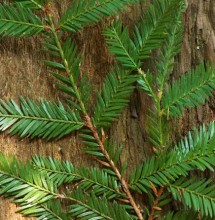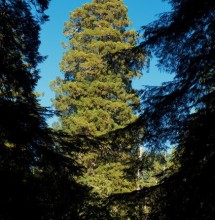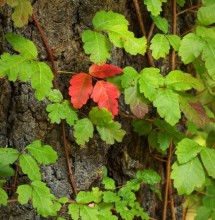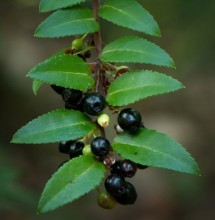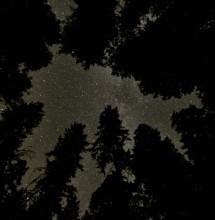Guest bloggers Doug and Joanne Schwartz – League members and dedicated volunteers – are serving this summer as our Redwood Explorers-in-Residence, exploring the northern parks, and ground-truthing and mapping the groves of ancient forest they find. Along the way, they’re documenting the many interesting plants, animals, and fungi they find in Redwood Watch, and blogging about their experiences. Continued from last week…
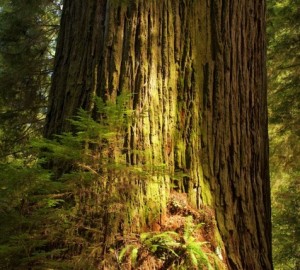
Tall Trees on a High Hill
The weather in Jedediah Smith State Park in late summer is remarkably predictable. We awaken to low clouds and fog in the mornings, which soon give way to brilliant blue skies after breakfast and about 75-degree temperatures in the afternoons. We sleep under a quilt in the humid and cool mid-50-degree nights.
This changed for us a couple of days ago while we were surveying the boundaries of an old-growth forest on the crest on a remote hill. We heard what at first seemed to be high-altitude aircraft. The sounds of what we thought were jets came closer and became recognizable as near-continuous rumbles of thunder. No longer did we see the dappled streaks of sunlight coming through the canopy, spotlighting the bigleaf maples down the hill. As the sound of thunder moved directly overhead and sky became dark, the forest took on an eerie sense of foreboding.
We knew we must retreat, at the top of a hill among very tall trees is not a safe place to be in a thunderstorm. Shattered treetops and blackened, hollowed-out redwoods serve as stark reminders of the ravages of summer lightning. While fire is an integral part of the redwood forest’s healthy functioning, it can quickly imperil hikers. Walking down the hill, we were reminded of the early 19th-century paintings of manifest destiny, which depict American pioneers emerging from the dreaded wilderness’ dark depths to the sunlight of civilization. Like those early trappers and settlers, we too were called by an emotional need to retreat and seek the security and comfort of our camper van. We laughed at these feelings.
Yes, it rained a tiny, scarcely-detectable amount. In the few places where there were breaks in the canopy, where light had earlier shone on the ground, scattered drops marked the soil. Most of the falling moisture was captured by the dense canopy of the redwood and Douglas fir trees, as it should be in these deep forests.
The Flat Leaf Society
As we move from area to area looking closely at redwood groves, we notice local differences. The Sitka spruce of Prairie Creek have been replaced by Douglas fir in the northern parks. Poison oak, already developing red leaves, is abundant in open areas like along rivers and the coast, but absent deep in the forest. Himalayan blackberries give way to huckleberries, and thickets of both cause us detours and delays. The mix of ferns and flowers and birds also changes.
Our major accomplishment has been to sort out the big trees from one another. It may seem a simple task, but redwoods, Sitka spruce, western hemlock and Douglas Fir (i.e., most of the giant trees in our northern California coastal forests) all have flat leaves.
We now have some clues: Redwoods have flat “hands” of flat leaves forming fronds along their branches.
Western hemlocks have similar structures, but with shorter leaves that overlap with twigs, making each frond slightly more fluffy looking. Douglas fir leaves are flat too, but point outward in all directions along each twig, giving the look of furry branches rather than flat fronds. Sitka spruce leaves are flat on four sides and are arrayed around the twigs like a stiff and prickly bottle-brush.
The bark, cones and overall structure of our four trees are also different in interesting ways, but as initiated members of The Flat Leaf Society, we now enjoy focusing on the little leaves.
Once You’ve Seen One Tree…
When trapper Jedediah Smith walked near here in the 1820s, he likely encountered grizzly bear, wolves, an abundance of salmon in clear running rivers, and a forest full of old-growth redwood trees. Traversing the forest was especially difficult for him. Today, the top predators have been eliminated by man for sport, protection of livestock and a sense of security. Salmon have been overfished and their waterways choked, dammed and polluted. And most of the large redwoods were cut to build an early San Francisco, as well as to create suburban backyard decks and fences.
As we roam the flats and hills of these northern coastal redwood parks, especially Jedediah Smith State Park this past week, we are simultaneously excited and awestruck. We lie under trees, steadying our binoculars on the intricacies of their oddly-formed branches spanning the sky above us. We circle the tree trunks with my five-foot arms and Doug’s six-foot arms extended fingertip to fingertip, measuring the circumference in 11-foot increments. We photograph bark and branches and burls, and bizarre arboreal forms like talons, knees and chandeliers. We gaze across valleys to see the tops of the tree-towers from afar, some puffy with new growth, and some naked, with shattered and spindly spires. We gaze at the night stars silently glittering through the treetops whenever the clouds and fog clear.
Together we talk and question, attempting to make sense of everything we see. Each tree is precious. Each view of a giant is momentous. Every tiny two-foot sapling gives us hope for people and for trees two thousand years in the future when a handful of these protected youth will become elderly. Then we sight one of our special charges, the next redwood along one of our old grove boundaries, and take another GPS reading for our study.
Certainly, making friends with the trees here is easier for us than it was for Jedediah Smith almost 200 years ago.
You can find pictures of natural history from Doug and Joanne’s travels on their gallery at ExplorerDJ.SmugMug.com.
